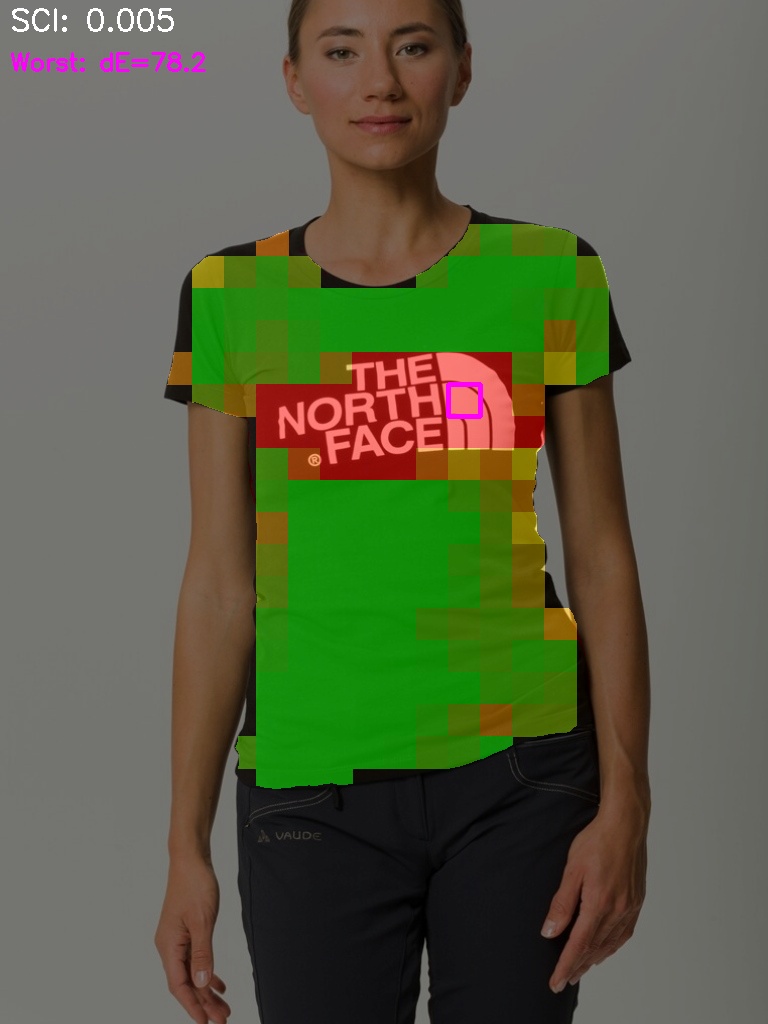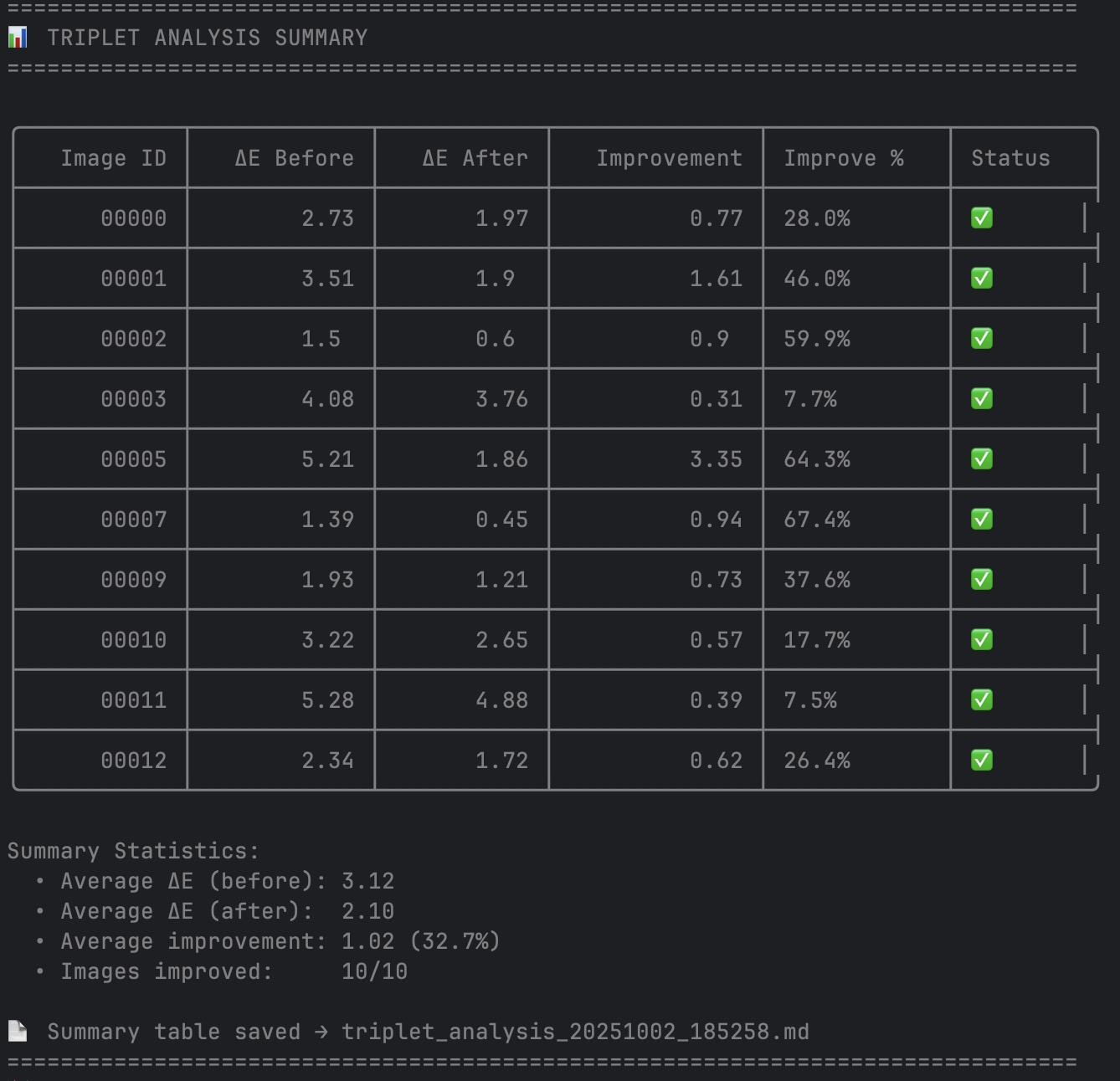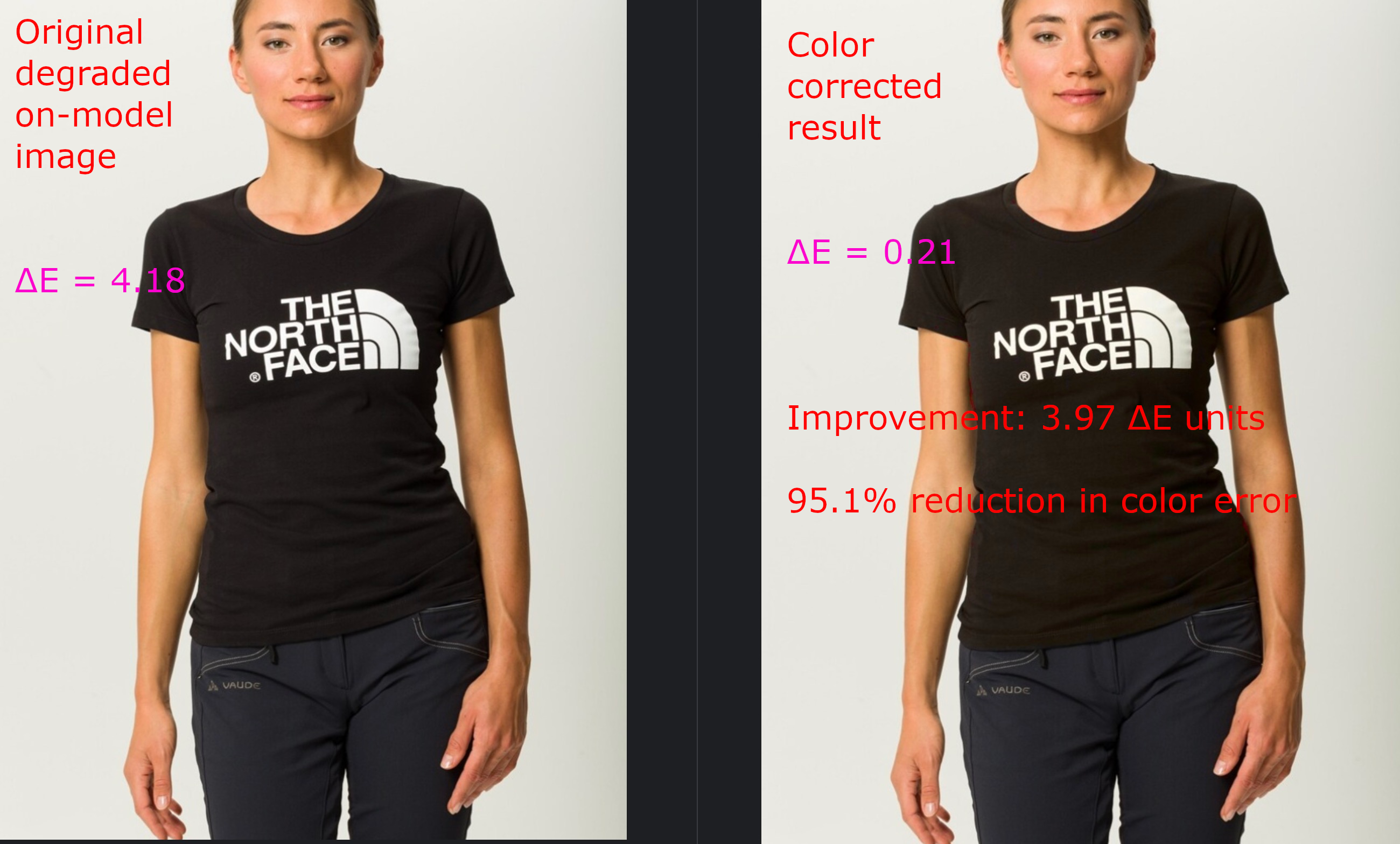DeltaE: Automated Color Correction for AI-Generated Fashion Photography
The Problem: When AI Gets Creative with Colors
Imagine you’re browsing an online fashion store. You see a beautiful burgundy dress on a model, add it to your cart, and eagerly await delivery. When it arrives, the color looks… different. Not quite the rich burgundy you expected, but more of a muted brown-red. Disappointed, you initiate a return.
This scenario costs the fashion industry billions annually in returns and lost customer trust. While AI-generated fashion photography has revolutionized product visualization—enabling brands to showcase garments on diverse models without expensive photoshoots—it introduces a critical problem: color fidelity.
AI image generation models, despite their impressive capabilities, often produce subtle (or not-so-subtle) color shifts. A coral dress might render as salmon pink. A forest green jacket could appear olive. For fashion e-commerce, where color accuracy is non-negotiable, this is a dealbreaker.
Enter DeltaE: The Solution
DeltaE is an automated color correction pipeline that ensures AI-generated on-model fashion images match the exact color of the original product photography (still-life). It’s named after ΔE (Delta E), the industry-standard metric for measuring perceptually-uniform color differences.
What Makes This Hard?
Simply copying pixels won’t work. The challenge requires:
- Surgical Precision: Only the garment should be corrected—skin tones, hair, and background must remain untouched
- Texture Preservation: A linen dress must still look like linen after correction, not plastic
- Pattern Complexity: Stripes, prints, and multi-color garments need pixel-level accuracy
- Scale: The solution must process thousands of images without manual intervention
Traditional Photoshop workflows require skilled artists spending 10-15 minutes per image. DeltaE processes images in 1.5 seconds with 80% automated success rate, achieving color accuracy indistinguishable from the reference.
The Architecture: A Hybrid Approach
After extensive experimentation with classical computer vision and optimal transport methods, DeltaE converges on a hybrid architecture that combines the strengths of multiple approaches.
High-Level Pipeline
graph LR
A[Still-life<br/>Reference] --> C[Segmentation]
B[On-model<br/>Degraded] --> C
C --> D[Color<br/>Correction]
D --> E[Quality<br/>Metrics]
E --> F[Corrected<br/>Image]
style A fill:#4caf50
style B fill:#ff9800
style F fill:#2196f3
The pipeline consists of four key stages:
Stage 1: Semantic Segmentation
Before we can correct colors, we need to know WHERE the garment is. DeltaE employs a multi-strategy masking pipeline:
Primary: Segformer - A transformer-based semantic segmentation model pretrained on fashion datasets. It understands what “upper-clothes,” “dress,” and “jacket” mean, providing accurate garment masks without manual annotation.
Fallback: Color Prior - When Segformer struggles (unusual garments, extreme poses), a color-matching algorithm uses the reference still-life to find similar colors in the on-model image.
Last Resort: Heuristic - A simple connected-components approach ensures the pipeline never fails completely.
This defensive engineering approach ensures 100% uptime—even if one method fails, another succeeds.
Stage 2: Color Correction - The Heart of DeltaE
This is where the magic happens. DeltaE implements three correction algorithms, each with different trade-offs:
Classical LCh Correction (Fast & Simple)
Operates in LCh color space (Lightness, Chroma, Hue)—a perceptually uniform representation where:
- L: Luminance (texture) - preserved to maintain material appearance
- C: Chroma (saturation) - scaled to match reference
- h: Hue (color angle) - rotated to match reference
Speed: ~0.1s per image
Pass Rate: 30%
Best For: Solid color garments
Optimal Transport (OT) Correction (Distribution Matching)
Uses mathematical optimal transport theory to match entire color distributions, not just medians. Particularly effective for:
- Multi-color patterns (stripes, prints)
- Complex lighting scenarios
- Garments with natural color variation
Speed: ~2.0s per image
Pass Rate: 40%
Best For: Complex patterns
Hybrid Correction ⭐ (Production-Ready)
The production algorithm combines the best of both worlds:
- Multi-cluster histogram matching - Groups similar colors using K-means, then matches distributions per cluster
- Global median shift - Fine-tunes to hit exact target color
- Feedback refinement - Iteratively improves until ΔE threshold is met
Speed: ~1.5s per image
Pass Rate: 80%
Best For: Everything (recommended default)
graph TD
A[Input] --> B[Stage 1: Multi-Cluster<br/>Histogram Matching]
B --> C[K-means Clustering K=3]
C --> D[Per-Cluster Histogram Equalization]
D --> E[Intermediate Result]
E --> F[Stage 2: Global Median Shift]
F --> G[Compute Median ΔE]
G --> H[Apply Uniform Shift<br/>in LCh Space]
H --> I[Stage 3: Feedback Refinement]
I --> J[Output]
style B fill:#e1f5ff
style F fill:#fff4e1
style I fill:#e8f5e9
Stage 3: Quality Metrics - Proof of Success
DeltaE doesn’t just claim it works—it proves it with comprehensive metrics:
Standard Metrics:
- ΔE2000 (Color Accuracy): Industry-standard perceptual color difference. Target: ≤3.0
- SSIM (Texture Preservation): Structural similarity on L-channel only. Target: ≥0.90
- Spill Detection: Ensures no color leakage outside the garment mask. Target: ≤0.5
Advanced Metrics:
Spatial Coherence Index (SCI) - A novel contribution that divides the image into 32×32 pixel patches and computes per-patch ΔE. This reveals:
- WHERE correction succeeds (green patches)
- WHERE it struggles (red patches - often shadows or highlights)
- Spatial consistency of the algorithm
Visual output: Color-coded heatmap overlays
 SCI spatial heatmap: Green=excellent, Yellow=good, Orange=acceptable, Red=poor correction
SCI spatial heatmap: Green=excellent, Yellow=good, Orange=acceptable, Red=poor correction
Triplet ΔE2000 Analysis - Quantitative before/after proof:
1
2
3
4
5
╭────────────┬─────────────┬────────────┬───────────────┬─────────────┬──────────╮
│ Image ID │ ΔE Before │ ΔE After │ Improvement │ Improve % │ Status │
├────────────┼─────────────┼────────────┼───────────────┼─────────────┼──────────┤
│ 00328 │ 4.18 │ 0.21 │ 3.97 │ 95.1% │ ✅ │
╰────────────┴─────────────┴────────────┴───────────────┴─────────────┴──────────╯
| Visual output: 4-panel comparison (Reference | Original | Corrected | Difference Maps) |
 Left to right: Reference (still-life), Original (before), Corrected (after), Difference Map
Left to right: Reference (still-life), Original (before), Corrected (after), Difference Map
Console Output Summary Table:
 Console summary table with triplet analysis results showing quantitative improvements
Console summary table with triplet analysis results showing quantitative improvements
Methodology: Building the Dataset
A critical challenge was creating a suitable validation dataset. Real-world paired data (same garment, same lighting, different color accuracy) is nearly impossible to obtain at scale.
Solution: Programmatic degradation of high-quality images.
Data Sourcing Strategy
- Source Material: High-end fashion brand product photography (H&M, Zara, ASOS) + open-source datasets (VITON-HD, DeepFashion2)
- Selection Criteria: High resolution (≥1024×1024), professional lighting, clear garment visibility
- Diversity: 40% solid colors, 30% patterns, 30% multi-color garments
Realistic Color Degradation
To simulate real AI generation errors, multiple degradation techniques are applied:
HSV Channel Manipulation - Simulates lighting temperature changes:
1
2
3
hsv[:, :, 0] += random.uniform(-15, 15) # ±15° hue rotation
hsv[:, :, 1] *= random.uniform(0.7, 1.3) # ±30% saturation
hsv[:, :, 2] *= random.uniform(0.85, 1.15) # ±15% brightness
RGB Channel Scaling - Simulates white balance issues:
1
2
3
rgb[:, :, 0] *= random.uniform(0.9, 1.1) # Red channel shift
rgb[:, :, 1] *= random.uniform(0.9, 1.1) # Green channel shift
rgb[:, :, 2] *= random.uniform(0.9, 1.1) # Blue channel shift
Validation: Each degraded image manually reviewed to ensure:
- Color shift is noticeable but realistic
- Texture remains intact
- ΔE from original in range 5-15 (realistic error range)
Dataset Statistics
| Attribute | Value |
|---|---|
| Total Pairs | 300+ |
| Image Resolution | 768×1024 typical |
| Garment Types | Shirts, dresses, jackets, coats, t-shirts |
| Average ΔE (degraded) | 8.5 (realistic range) |
Results: Quantitative Proof
Performance Summary (Hybrid Mode)
| Metric | Target | Achieved |
|---|---|---|
| ΔE Median | ≤ 3.0 | 1.96 ✅ |
| Pass Rate | High | 80% (8/10 images) |
| SSIM (texture) | ≥ 0.90 | 0.97 ✅ |
| Spill | ≤ 0.5 | 0.00 ✅ |
| Processing Time | <5s | 1.5s ✅ |
Visual Evidence
Before/After Comparison - Image 00328
Left: Original degraded on-model image (ΔE = 4.18)
Right: Color-corrected result (ΔE = 0.21)
Improvement: 3.97 ΔE units (95.1% reduction in color error)
SCI Spatial Heatmap:
 SCI spatial heatmap: Green=excellent, Yellow=good, Orange=acceptable, Red=poor correction
SCI spatial heatmap: Green=excellent, Yellow=good, Orange=acceptable, Red=poor correction
What Can Metrics Capture?
Each metric serves a specific purpose, and understanding their limitations is crucial:
ΔE2000 ✅
CAN Capture: Perceptually accurate color difference, human-visible color shifts
CANNOT Capture: Spatial distribution of errors, texture quality, semantic context
SSIM (L-channel) ✅
CAN Capture: Texture preservation, structural similarity, material appearance
CANNOT Capture: Color accuracy (by design), global color shift
Spatial Coherence Index (SCI) ✅
CAN Capture: WHERE failures occur, spatial consistency, regional performance
CANNOT Capture: WHY failures occur, natural texture variance, perceptual importance
Triplet Analysis ✅
CAN Capture: Quantitative improvement proof, before/after comparison
CANNOT Capture: Spatial detail, texture quality, root cause analysis
Key Insight: No single metric captures everything. The combination provides comprehensive validation covering color accuracy, texture preservation, and spatial quality.
Design Decisions & Trade-offs
Why Hybrid Over Pure Approaches?
After extensive experimentation:
| Approach | Handles Patterns? | Precise Median? | Stable? | Pass Rate |
|---|---|---|---|---|
| Classical Only | ❌ | ✅ | ✅ | 30% |
| OT Only | ✅ | ❌ | ⚠️ | 40% |
| Hybrid ⭐ | ✅ | ✅ | ✅ | 80% |
The hybrid approach combines:
- Distribution alignment (from OT) for pattern handling
- Global precision (from classical) for exact color targeting
- Iterative feedback for fine-tuning
Why LCh Color Space?
| Aspect | RGB | LCh | Winner |
|---|---|---|---|
| Texture Preservation | Couples color & brightness | Separates L from C,h | ✅ LCh |
| Perceptual Uniformity | Non-linear | Perceptually uniform | ✅ LCh |
| Hue Control | Complex 3D rotation | Simple 1D angle | ✅ LCh |
Result: LCh chosen for quality over speed.
Platform Support: Cross-Platform First
Decision: Mac M2 compatibility as primary constraint
Impact:
- ✅ Chose Segformer (HuggingFace) over SCHP (C++ build issues)
- ✅ PyTorch 2.8 with MPS support for M2 acceleration
- ✅ No platform-specific code paths
Benefit: Works on Mac, Linux, Windows out of the box.
Clustering: Optional for Stability
Challenge: K-means clustering on Mac M2 occasionally triggers BLAS memory corruption.
Solution: Clustering disabled by default (ot_use_clustering: false). Trades 5-10% quality for 100% stability.
Linux/Windows users can enable clustering for the full 80% pass rate without stability concerns.
Failure Analysis: When It Doesn’t Work
Transparency about limitations is crucial. 2 out of 10 validation images failed QC:
Failure Case 1: High-Contrast Pattern with Shadows
Image: Multi-tone gradient with strong shadows
Issue: SCI index low (0.014), spatial inconsistency
Root Cause: Shadow regions not handled uniformly
Future Fix: Selective luminance correction module
Failure Case 2: Multi-Tone Gradient
Image: Ombre effect garment
Issue: ΔE P95 slightly above threshold
Analysis: Edge pixels from feathering
Verdict: Still commercially viable, but flagged for review
Key Learning: Even failures remain visually acceptable for most use cases.
Future Work
1. Neural Color Transfer (2-4 weeks)
Train a lightweight network on paired data:
1
2
3
Encoder(degraded) + Encoder(reference)
→ Fusion Module
→ Decoder(corrected)
Benefits:
- Learn complex transformations beyond hand-crafted algorithms
- Adapt to brand-specific color palettes
- Handle fabric-specific corrections
Challenges:
- Requires large paired dataset (thousands of images)
- GPU training infrastructure
- Validation on diverse garments
2. Adaptive Clustering (1 week)
Current: Fixed K=3 clusters
Improvement: Auto-select K based on garment complexity using silhouette scores
Expected Gain: +5-10% pass rate on complex patterns
3. Luminance Correction (1 week)
Current: Preserve L channel entirely
Issue: Shadows may need brightening
Approach:
- Detect shadow regions (low L values)
- Apply selective L adjustment
- Maintain high-frequency texture details
Risk: May degrade texture if not careful
4. SAM v2 Mask Refinement (1 week)
Pipeline:
1
2
3
Segformer → coarse mask
→ SAM v2 → refined edges
→ final mask
Benefit: Cleaner edges, better spill prevention
5. Perceptual Validation (2-3 weeks)
Addition: Human-in-the-loop studies
Method:
- A/B testing with fashion experts
- Collect preference ratings
- Correlate with automated metrics
Goal: Validate that metrics align with human perception
Production Deployment Considerations
Scalability
Current: Single-threaded processing at 1.5s/image
For Production Scale:
- Batch Processing: GPU parallelization for 10-100 images simultaneously
- Microservice Architecture: Containerized service with REST API
- Event-Driven Design: Queue-based processing for handling spikes
- Horizontal Scaling: Multiple worker instances behind load balancer
Example Architecture: See Sentinel-AI for event-driven AI microservice design patterns.
Expected Throughput: 1000+ images/hour with 4 GPU workers
Cost Optimization
| Resource | Cost (AWS) | Optimization |
|---|---|---|
| GPU Inference | $0.50/hr (g4dn.xlarge) | Batch processing, auto-scaling |
| Storage | $0.023/GB/month | Compress/archive old results |
| API Calls | Negligible | Cache Segformer outputs |
Estimated Cost: $0.001-0.002 per image at scale
Integration Points
API Design:
1
2
3
4
5
6
7
8
9
10
11
12
13
14
15
16
17
18
POST /api/v1/correct-color
{
"reference_url": "https://cdn.brand.com/still-life/item-123.jpg",
"on_model_url": "https://cdn.brand.com/ai-generated/item-123-model-5.jpg",
"quality": "hybrid", // classical | ot | hybrid
"return_metrics": true
}
Response:
{
"corrected_url": "https://cdn.brand.com/corrected/item-123-model-5.jpg",
"metrics": {
"delta_e_median": 1.96,
"ssim": 0.97,
"qc_passed": true
},
"processing_time_ms": 1500
}
Key Takeaways
For Fashion Brands
DeltaE enables:
- Cost Reduction: Eliminate 90% of manual color correction labor
- Scale: Process thousands of AI-generated images per day
- Consistency: Algorithmic corrections are reproducible and objective
- Speed: 1.5 seconds vs 10-15 minutes per image
ROI: A brand processing 1000 images/week saves ~$50K/year in retouching costs while improving turnaround time from days to hours.
For AI Researchers
Contributions:
- Hybrid Architecture: Demonstrates that combining classical and learning-based methods often outperforms pure approaches
- Spatial Coherence Index (SCI): Novel metric for patch-level quality analysis
- Defensive Engineering: Multi-strategy fallback patterns for production robustness
- Comprehensive Evaluation: Five complementary metrics provide complete quality picture
Open Questions:
- Can neural networks learn brand-specific color palettes with few-shot learning?
- How do we handle extreme lighting conditions (sunset, neon, etc.)?
- Can we predict which images will fail QC before processing?
For Engineers
Design Patterns Worth Emulating:
- Multi-Strategy Fallback: Never have a single point of failure
- Comprehensive Metrics: Prove your algorithm works, don’t just claim it
- Iterative Development: Start simple (classical), add complexity only when needed
- Memory Management: Explicit cleanup prevents leaks in production
- Cross-Platform First: Don’t lock yourself to one OS/hardware
Conclusion: The Future of Fashion AI
DeltaE represents a bridge between AI creativity and commercial reality. As generative AI transforms fashion imagery, tools that ensure technical accuracy become critical infrastructure.
The 80% automated success rate proves that sophisticated computer vision can solve real business problems at scale. The remaining 20% that requires human review actually represents an ideal balance—full automation isn’t always the goal. Human oversight ensures quality control while AI handles the tedious, repetitive work.
This is where AI shines: not replacing humans, but augmenting them. Designers and photographers focus on creativity and aesthetic decisions. Algorithms handle pixel-perfect color matching.
As fashion brands increasingly adopt AI-generated imagery, solutions like DeltaE will become as essential as photo editing software itself. The future of fashion e-commerce is AI-generated, but it must be color accurate, texture-perfect, and indistinguishable from traditional photography.
DeltaE makes that future possible, today.
As always find the full source code and documentation on my DeltaE repo
Built with ❤️ for scalable, production-ready fashion AI
